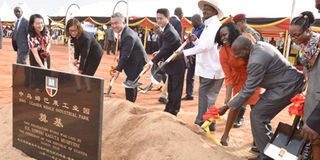Which sector should new industrial policy prioritise?

President Yoweri Museveni launches the Sino-Uganda Industrial park in Mbale District in March this year. Investors establishing industries in traditional towns and others areas in the country will be given 10-year-tax holiday for all manufacturing including agricultural processing. Photo by Rachel Mabala
What you need to know:
- While the services sector contributes the largest Gross Domestic Product - 51 per cent - to the economy, economists argue that economies develop with industries and not services. Ismail Musa Ladu explains what the preferred sectors of focus should be – agro-processing and extractives once the new national industrial policy takes shape.
After nearly 10 years of haphazard implementation of the country’s first National Industrial Policy, its usefulness came to a grinding halt over 10 months ago.
Only 30 per cent of the National Industrial Policy strategies were implemented since the document was created.
Economic analysts say for the industrial policy to be effective, its design and implementation should consider both government’s capabilities and political will.
However, efforts to have a new one, titled, “National Industrial Development Policy,” are already in advanced stages. Signals from the political wing indicate that this time, there will be more commitment in enforcing the plans.
While presenting the sector performance report at the 9th annual sector review recently, the Minister of trade Ms Amelia Kyambadde, whose ministry is responsible for implementing the plan, said the policy will be ready for enforcement over the next two months.
But before that, while speaking at the Validation Workshop for the Draft National Industrial Development Policy, 2018 and its Strategic plan, Ms Kyambadde said industrialisation is critical for the socio-economic development of this country. The industrial policy will provide a clear plan on how to execute this agenda.
Uganda was among the few African countries with a thriving industrial sector prior to independence. With the establishment of the Uganda Development Corporation (UDC) in 1952, industry was accorded priority in the country’s development efforts. However, this prosperity in the industrial sector, according to Ms Kyambadde was short-lived due to the political turmoil that characterised the post-independence Uganda.
Despite criticism regarding implementation of the policy, Ms Kyambadde argued that all was not doom and gloom. She said since 1986, several reforms have been undertaken including the formulation and implementation of the first National Industrial Policy, 2008. This Policy was developed as a framework for Uganda’s transformation, competitiveness and prosperity.
While implementing the industrial policy over the last 10 years, Ms Kyambadde noted that there were some achievements. Over that period, she said policies that have been approved include: “National Textile Policy 2008, National Sugar Policy 2010, National Standards and Quality Policy 2012, Accreditation Policy 2014, National Leather and Leather Products Policy 2015, National SME Policy 2015, National Grain Trade Policy 2015 and Packaged Water Policy, 2015.”
However, according to a report titled: “Economic Development and Industrial Policy in Uganda,” conducted by Ramathan Ggoobi, Benard Musekese Wabukala and Joseph Ntayi the achievements registered over the 10 years are still lacking.
The study disclosed that many of the key players in Uganda current development circles that were interviewed hold the view that the overall development strategy was uncoordinated, badly communicated, poorly understood and it wasn’t successfully implemented.
New National Industrial policy
According to Ms Kyambadde, the challenges that the new policy hopes to address include; lowering the cost of manufacturing especially in regard to energy and transport, lowering the cost of industrial finance, widening the industrial base and improving integration with agriculture and other domestic natural resources.
It will also address the requisite skills for Ugandan industrial workers, upgrading technology used in industries, improving efficiency of industrial operations and better resource utilisation in the industrial sector.
Focus and priority
Already, there is a difference in opinion regarding the title of the new policy currently in draft form. Some argue that the word ‘industrial’ does not necessary refer to the industry preferring the word ‘industrialisation’ instead. That aside, the bigger question is where the priority and the focus of the policy will be directed.
In her remarks, at the validation of the draft National Industrial Development Policy recently in Kampala, the United Nation Development Programme (UNDP) country director, Ms Almaz Gebru, noted: “Unless Uganda industrialises, it will not create high quality growth, good jobs and diversify its export earnings. This means the most desired policy goal of catching up with the rest of the world will remain a myth.”
She continued: “Industrialisation in Uganda and the rest of Africa, being late comers, must be done differently by focusing on parameters that give us a niche to enable us enter the global market.”
Uganda should industrialise with what it possesses. Ms Gebru recommends agriculture and extractives as some of the immediate resources to think about.
To achieve the goals set in the policy, she proposed that coordination among institutions of government be made a priority, she observed.
Among several other recommendations, the Economic Development and Industrial Policy in Uganda study recommends harnessing of technology, innovation, productivity and linkages. This includes collaborating with research institutions. But there should be increased investment in agricultural production and agro-processing so that the manufacturing sector can take advantage of the comparative advantage in agricultural commodities.
A study produced by the Southern and Eastern Africa Trade Information and Negotiations Institute (SEATINI-Uganda) with support from CUTS International, examining the linkage between National Industrial Development Policy with agro-processing, trade, climate change, food security and gender disclosed that there are glaring challenges in cementing the above together.
According to the authors of the report, Ms Jane Nalunga, Joseph Bukenya and Faith Lumonya, for any development to occur, the draft policy must incorporate, recognise and promote issues of agro-processing, climate change, food security, trade, gender and their complex interconnections.
The study further revealed that all the above are interlinked and that each variable relates to another in a cause-effect relationship.
Reason to worry
The services sector is now the largest sector in the economy. Its contribution to GDP is beyond 51 per cent with a growth rate of 9.4 percent, faster than the growth rates in the agriculture and industrial sectors for the same year.
But economists like Dr Ngoobi and researcher Isaac Shinyekwa of the Economic Policy Research Centre, argue that economies develop with industries and not services.
Therefore, the country should work towards reversing the statistics in favour of industrial growth. Unless that happens, the economy and quality of life will either stagnate or dwindle.
Industrialisation in Uganda
•Industrial policy is defined as the strategic effort by the state to encourage the development and growth of a sector of the economy. It refers to any type of selective intervention or government policy that attempts to alter the structure of production towards sectors that are expected to offer better prospects for economic growth than would occur in the absence of such intervention.
•Industry accounts for 21 per cent of Uganda’s GDP and employs about 7 per cent of the labour force.
•In addition, the industry focuses on the production of fertilisers and processing of skin into leather, and silk and cotton textile. However, the textile sector is negligible compared to the regional giants (Kenya and Ethiopia) and only 5 per cent of the cotton produced in Uganda is subsequently used by local factories.
Industrialisation dream
What success looks like
The construction sector has witnessed major growth since the 1990s liberalisation, supported by government-initiated infrastructure projects such as the Isimba hydro-electric plant or the oil pipeline to Dar-es-Salaam.
But in the longer term, the sector’s success will depend on the capacity of the manufacturing industry to provide the necessary goods and equipment to reduce import dependence.
Mining sector
Manufacturing allows the country to yield more benefits from its agricultural production. The agro-food sector is processing coffee, tea, nuts, dairy products, fruits and vegetables, canning of animal products and forage production.
The mining industry is engaged in the extraction of iron, gold, cobalt, copper, tin, wolframite, cement and phosphates.
The mining industry will soon see an unprecedented boom when oil production starts. Uganda has reserves of 6.5 billion barrels, of which 2 billion will be exploitable.
Challenges
About 90 per cent of firms in the manufacturing sector are SMEs. Large companies are mainly foreign. They arrived with the wave of liberalisation of the 1990s and concentrated in the metallurgical, textile, tannery, cement, brewing and bottling activities.
The main struggles of the manufacturing industry is the cost and access to electricity, poverty which impedes domestic demand and competition from imported products.



